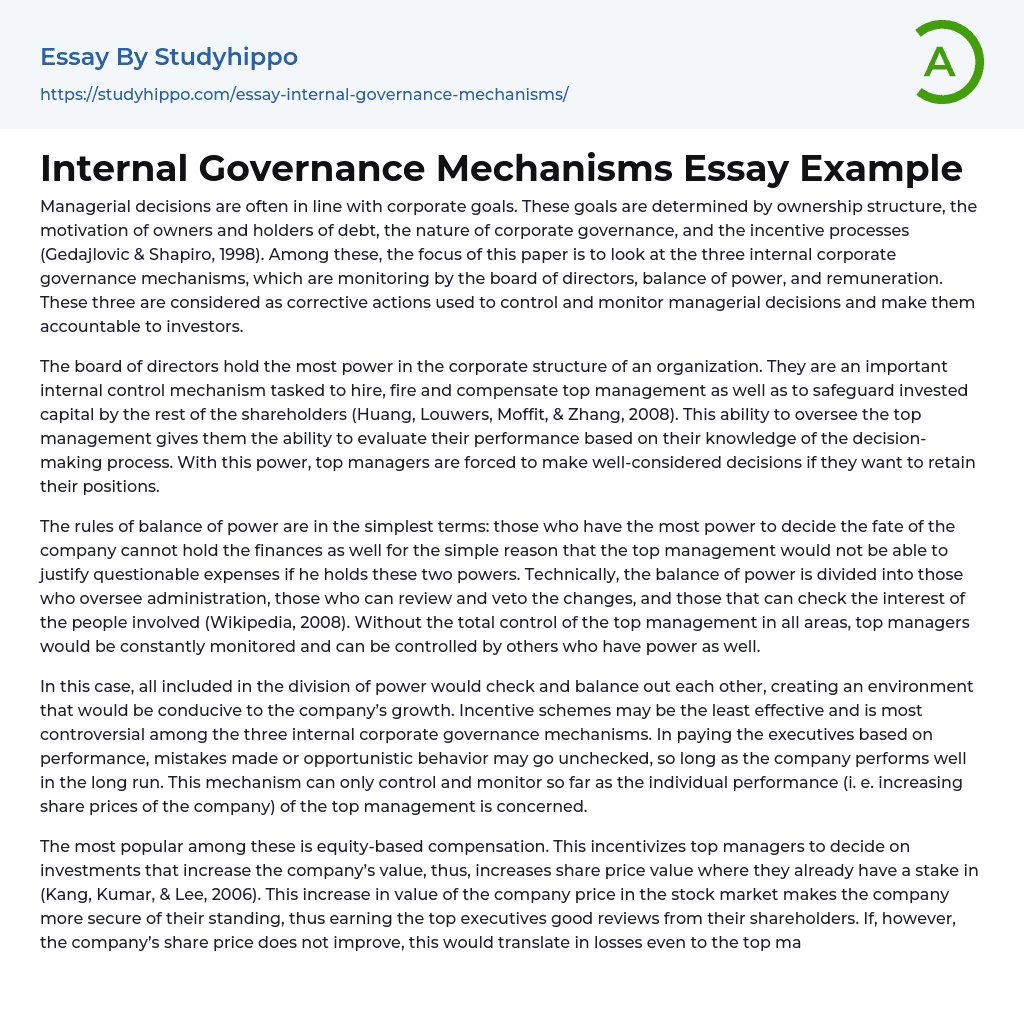Managerial decisions are often in line with corporate goals. These goals are determined by ownership structure, the motivation of owners and holders of debt, the nature of corporate governance, and the incentive processes (Gedajlovic & Shapiro, 1998). Among these, the focus of this paper is to look at the three internal corporate governance mechanisms, which are monitoring by the board of directors, balance of power, and remuneration. These three are considered as corrective actions used to control and monitor managerial decisions and make them accountable to investors.
The board of directors hold the most power in the corporate structure of an organization. They are an important internal control mechanism tasked to hire, fire and compensate top management as well as to safeguard invested capital by the rest of the shareholders (Huang, Louwers, M
...offit, & Zhang, 2008). This ability to oversee the top management gives them the ability to evaluate their performance based on their knowledge of the decision-making process. With this power, top managers are forced to make well-considered decisions if they want to retain their positions.
The rules of balance of power are in the simplest terms: those who have the most power to decide the fate of the company cannot hold the finances as well for the simple reason that the top management would not be able to justify questionable expenses if he holds these two powers. Technically, the balance of power is divided into those who oversee administration, those who can review and veto the changes, and those that can check the interest of the people involved (Wikipedia, 2008). Without the total control of the top management in all areas, top managers would b
constantly monitored and can be controlled by others who have power as well.
In this case, all included in the division of power would check and balance out each other, creating an environment that would be conducive to the company’s growth. Incentive schemes may be the least effective and is most controversial among the three internal corporate governance mechanisms. In paying the executives based on performance, mistakes made or opportunistic behavior may go unchecked, so long as the company performs well in the long run. This mechanism can only control and monitor so far as the individual performance (i. e. increasing share prices of the company) of the top management is concerned.
The most popular among these is equity-based compensation. This incentivizes top managers to decide on investments that increase the company’s value, thus, increases share price value where they already have a stake in (Kang, Kumar, & Lee, 2006). This increase in value of the company price in the stock market makes the company more secure of their standing, thus earning the top executives good reviews from their shareholders. If, however, the company’s share price does not improve, this would translate in losses even to the top management whose additional incentives are tied to the prices of shares he has a stake in.
- Investing essays
- Asset essays
- Depreciation essays
- Discounted Cash Flow essays
- Foreign Direct Investment essays
- Funds essays
- Internal Rate Of Return essays
- Revenue essays
- Day Trading essays
- Futures Trading essays
- Capital market essays
- Million essays
- Payment essays
- Rate Of Return essays
- Funding essays
- Hedge Fund essays
- Absolutism essays
- Appeal essays
- Bourgeoisie essays
- Contras essays
- Corporate Governance essays
- Corruption essays
- Democracy essays
- Democratic Party essays
- Developed Country essays
- Dictatorship essays
- Elections essays
- European Union essays
- Federalism essays
- Foreign essays
- Foreign policy essays
- Gentrification essays
- Hillary Clinton essays
- Income Tax essays
- International Relations essays
- John Marshall essays
- John Stuart Mill essays
- Left-Wing Politics essays
- Liberty essays
- Military essays
- Monarch essays
- Monarchy essays
- Political Corruption essays
- Political Party essays
- Political Science essays
- President Of The United States essays
- Public Service essays
- Red Cross essays
- Reform essays
- Republic essays




